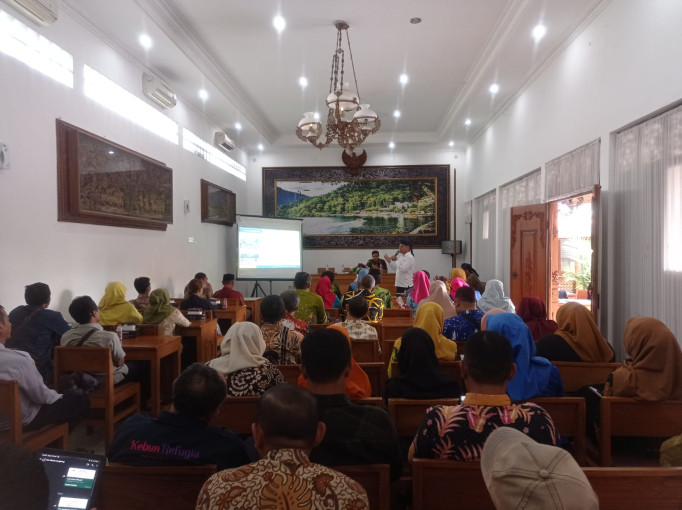
Magetan Regency Government is serious about promoting and establishing tourism as a leading sector.
This commitment requires synergy in strengthening four pillars of tourism development: destination development, tourism industry, institutionalization, and tourism marketing.
Undeniably, the revenue from the tourism sector in Magetan Regency primarily comes from Telaga Sarangan.
Unfortunately, the establishment of various amenities, including accommodations and restaurants in Sarangan around the slopes of Mount Lawu, has not been well-organized.
Their presence must be controlled to prevent green environments from being replaced by concrete buildings due to pressures from tourism development.
Dr. Destha Titi Raharjana, head of the Magetan Regional Tourism Master Plan (Ripparda) 2025-2034 research team, emphasized the Magetan Regency Government’s desire to restructure Magetan’s tourism through the Tourism Master Plan.
He believes that comprehensive research is needed to develop the tourism sector in Magetan Regency. The research should be adjusted to the area’s development and the current factual situation of tourism in Magetan, especially around Telaga Sarangan.
“A serious effort is needed to develop the tourism sector in Magetan Regency, and comprehensive research is required,” said Dr. Raharjana during the Focus Group Discussion (FGD) on Magetan Regency Regional Tourism Development 2024 as a Guideline for Regional Tourism Development, Thursday, Jul. 18, 2024.
Dr. Raharjana explained that Magetan Regency has a diverse ecosystem.
Preliminary research by the UGM Center for Tourism Studies (Puspar UGM) shows that the tourism character in Magetan primarily highlights nature tourism, supported by various cultural and creative economy tourism activities.
According to him, these three elements strengthen Magetan’s tourism icon.
Eka Radityo, Head of the Tourism Management Division of Magetan Regency Culture and Tourism Office, stated that local government revenue from the tourism sector in 2023 reached 20.3 billion rupiahs, exceeding the previous target of 19.2 billion rupiahs.
He mentioned that tourist visits to Magetan, especially around Telaga Sarangan, are notably high during holiday seasons, often causing traffic congestion.
“This indicates that Telaga Sarangan is superior to other tourist attractions. Unfortunately, the length of stay (LoS) and tourist spending in Magetan are still relatively low. Therefore, we continue to encourage the development of alternative tourist attractions to grow and attract more tourists,” he explained.
For this reason, he hopes that sports tourism will become a potential development opportunity in Magetan Regency.
This effort can be pursued through the development of Selendang Lawu, which aims to open and promote opportunities to enhance the potential in sub-districts and villages around the slopes of Mount Lawu.
“The development of tourist villages has so far been one of the efforts made to capture and retain tourists so that tourists in Magetan stay for more than three to six hours,” Eka Radityo elaborated.
The discussion also included other Puspar UGM researchers, Khusnul Bayu Aji and Nissa Larasati.
The event was attended by around 40 tourism stakeholders, including OPD leaders, sub-district heads, Pokdarwis, art and creative economy practitioners, tourist village managers, and representatives from the Indonesian Hotel and Restaurant Association (PHRI) and Pokdarwis.
Khusnul Bayu Aji presented preliminary findings, showing that Magetan Regency has 58 tourist attractions (DTWs) spread across several districts. This number is expected to continue growing as DTW identification processes continue.
Plaosan District has the most DTWs in the Magetan Regency, with around 18 DTWs (29.31%). Meanwhile, of the 58 tourist attractions, 51.85% are nature tourism types, 33.34% are cultural tourism types, and 14.81% are artificial tourism types.
Based on tourist visit levels, several top tourist attractions in Magetan include Telaga Sarangan, Mojosemi Forest Park, Taman Genilangit, and Kebun Bunga Refugia. In terms of tourism facilities, Magetan has 149 hotels with a total of 1,932 rooms.
“Unfortunately, among these hundreds of hotels, none are star-rated hotels that meet the qualifications to host large-scale events. This condition presents a challenge for Magetan, considering that MICE (Meeting, Incentive, Convention, Exhibition) tourism has great potential for development,” explained Khusnul Bayu Aji.
Another research team member, Nissa Larasati, highlighted the use of the internet as a support facility for tourism marketing.
Although crucial, many tourist attractions, including tourist villages in Magetan, have not yet maximized social media as a platform for promoting tourism.
“Public willingness to contribute to tourism development is still low, which presents a challenge. Therefore, the synergy between the community, government, and related OPDs is essential in promoting and developing tourist attractions beyond Telaga Sarangan so that tourist visits to Magetan are evenly distributed and can be packaged in various tourism packages,” said Larasati.
Author: Agung Nugroho
Post-editor: Lintang

